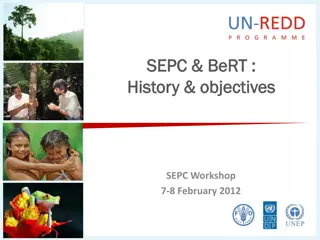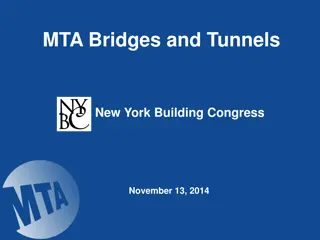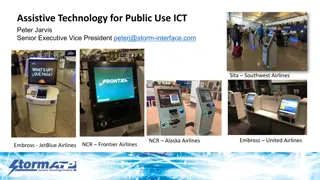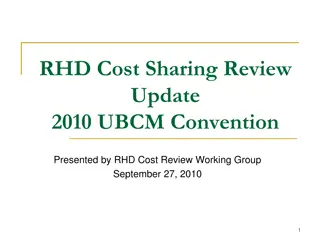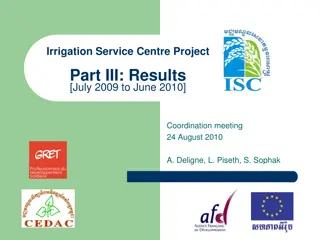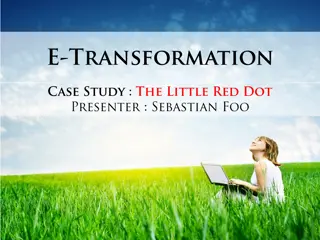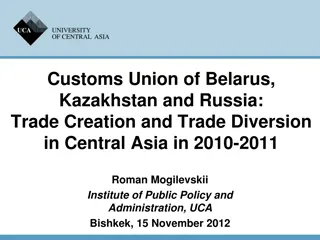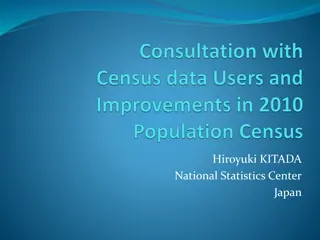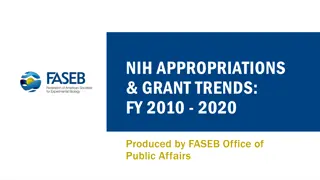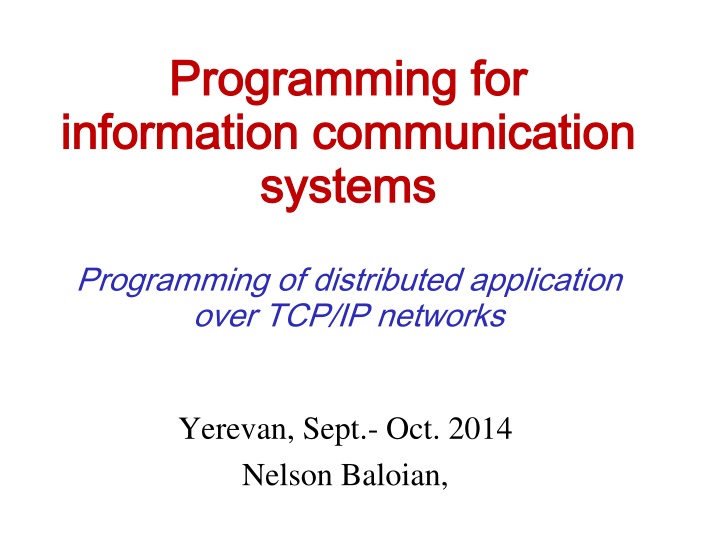
Programming for Information Communication Systems Overview
Explore the comprehensive course on programming for information communication systems, covering concepts of distributed systems, TCP/IP programming, client-server communication, UDP programming, RMI, servlets and JSP, and more. Join the course in Yerevan from Sept.-Oct. 2014 to enhance your skills in developing distributed applications over networks.
Download Presentation

Please find below an Image/Link to download the presentation.
The content on the website is provided AS IS for your information and personal use only. It may not be sold, licensed, or shared on other websites without obtaining consent from the author. If you encounter any issues during the download, it is possible that the publisher has removed the file from their server.
You are allowed to download the files provided on this website for personal or commercial use, subject to the condition that they are used lawfully. All files are the property of their respective owners.
The content on the website is provided AS IS for your information and personal use only. It may not be sold, licensed, or shared on other websites without obtaining consent from the author.
E N D
Presentation Transcript
Programming for Programming for information communication information communication systems systems Programming of distributed application over TCP/IP networks Yerevan, Sept.- Oct. 2014 Nelson Baloian,
Content 0. Introduction (concepts of distributed systems) 1. TCP/IP client & server programming Client programming: a simple client (date, echo) a pop3 client A SMTP client 2. Server programming (and their clients) Simple client-server example with serializing example File Servers: simple whole file iterative server (not secure) Simple whole file robust server Simple whole file concurrent server Stateless random access file server TCP/IP Chat with awareness A simple extensible web server Parallel downloading techniques Awareness in a TC/IP peer to peer environment and the latecomers problem
Content 3. UDP programming - simple UDP client-server example - a "ping" program - multicasting - multicasting chat - awareness in a multicasting environment - broadcasting vs. multicasting 4. RMI Client-server programming - a simple example will be used to show: remiregistry, concurrency automatic stub distribution - a sequential file server with state - Automatic teller machine example - RMI-based chat with awareness 5- Introduction to servlets and jsp - principles - parameters (from request and parameter file) - using forms - implementing state with cookies/sessions 6- JDBC
Evaluation Attending to classes (at least 80%) 3 homeworks Participation in classes Our webpage at http://www.dcc.uchile.cl/nbaloian/cc50h/2014/ Final Exam
Schedule Mondays: 9:30 11:20 Wednesdays : 9:30 11:20 Firdays : 9:30 11:20 From Sept. 22 to Oct 20
How to follow the lectures During classes: Download and run the examples by yourself Keep the programs in your computer and write comments (many do not have any) Follow the class: I will ask you to tell me what do the programs do After classes: Read the lecture again,
Why distributed systems - Share resources (25 years ago) - Communicate people (now) - Performance, scalability (always) - Fault tolerant systems (always)
Which distributed programs do I use? 1- Chat 2- email 3- p2p file sharing 4- web browser-server 5- database software 6- file server
Can you guess how were they developed ? 1- Programming language and resources used 2- Connection style 3- Communications architecture 4- Software architecture 5- Server design (if any)
Internet : two different ways to deliver a message to another application Applications programmers decide on this according to their needs The UDP: User Defined Package: like writing a letter TCP or UDP
Every layer has the illusion of talking to the same one located at the other host A The UDP: User Defined Package: like writing a letter Read write sequence CLIENT A SERVER 4444 UDP or TCP communication A CLIENT Internet frames and addresses A CLIENT electric pulses
Programming Communications in a TCP/IP Network At a low level ( future assembler of the communications ?) Based on the sockets & ports abstractions Originally developed for BSD UNIX but now present in almost all systems (UNIX, LINUX, Macintosh OS, Windows) The destination of a message is determined by the computer s IP number and the port number Every machine has 216 ports The origin of the message is also a socket but most of the times the port number is not important Ports are associated to services (programs)
The 3 basic communication forms UDP communication reflects almost what really happens over the internet. An application sends a packet trough a socket addressed to a certain IP number and port. There should be another application on that host listening to packets coming to that port (which is agreed beforehand) TCP simulates a data flow. A client must establish a communication with the server before starting sending/receiving data. The server must be waiting for such request. Multicast fits well for group communication when the group is not well defined beforehand (spontaneous networking). It is also based in the sending of UDP packages but all interested applications may receive it. It does not require a central server
Protocols for communication Every service is normally identified by a port Web: HTTP (port 80) Mail: SMTP (port 25) File transfer protocol: FTP (21) telnet: 22/23 More common services ports at: http://www.chebucto.ns.ca/~rakerman/port-table.html Servers with/without Connection connectionless style: UDP connection-oriented style TCP
The SOCKET When a server wants to start listening it must create a socket bound to a port. The port is specified with a number. www.informatik.de 4444 A SERVER 1 3333 A SERVER 2 A SERVER 3 5555 If a client wants to communicate with server 1 should try to communicate with computer www.informatik.de through port 4444
UDP: communication with datagrams DATAGRAM: an independent, self-contained message sent over the internet whose arrival, arrival time and content are not guaranteed (like regular mail in some countries....) Once a server is listening, the client should create a datagram with the server s address, port number and, the message www.waseda2.jp www.informatik.de A CLIENT ? A SERVER 4444 www.waseda1.jp 4444 message
Sending datagrams with UDP protocol Then it should open a socket and send the datagram to the internet. The routing algorithm will find the way to the target computer www.waseda2.jp www.informatik.de A ? A SERVER CLIENT 3333 4444
Sending datagrams with UDP protocol Before the datagram leaves the client, it receives the address of the originating computer and the socket number www.waseda2.jp www.informatik.de A ! A SERVER CLIENT 3333 4444
Sending datagrams with UDP protocol After the datagram is sent, the client computer may start hearing at the port created for sending the datagram if an answer from the server is expected www.waseda2.jp www.informatik.de A ? A SERVER CLIENT 3333 4444
Sending datagrams with UDP protocol The server can extract the client s address and port number to create another datagram with the answer www.waseda2.jp www.informatik.de A ? A SERVER CLIENT 3333 4444 answer
Sending datagrams with UDP protocol Finally is sends the datagram with the answer to the client . When a datagram is sent there is no guarantee that it will arrive to the destination. If you want reliable communication you should provide a checking mechanism, or use ... www.waseda2.jp www.informatik.de A ? A SERVER CLIENT 3333 4444
TCP: communication with data flow With TCP a communication channel between both computers is built and a reliable communication is established between both computers. This allows to send a data flow rather tan datagrams. www.waseda2.jp www.informatik.de A ? A SERVER CLIENT 3333 4444
TCP: communication with data flow After the client contacts the server, a reliable channel is established. After this, client and server may begin sending data through this channel. The other should be reading this data: They need a protocol !!!! www.waseda2.jp www.informatik.de bla bla A bla bla A SERVER CLIENT 3333 4444
TCP: How is data flow simulated ? The internet itself works only with the datagram paradigm. Internet frames are may get lost (destroyed): For every frame delivered carrying a part of the data flow there is a confirmation! Sending 1st bla Sending bla bla bla Ack 1st bla Sending 2nd bla Ack 2nd bla Sending 3rd bla Ack 3rd bla
What if a message get lost ? The server waits a certain amount of time. If it does not receive any confirmation it sends the message again. Sending 1st bla Sending bla bla bla Ack 1st bla Sending 2nd bla LOST !!! Sending 2nd bla again No confirmation !!! Ack 2nd bla
The Window for improving efficiency The transmitter will handle a set of not acknowledged packets Sending 1st bla Sending 2nd bla Sending 3rd bla Ack 1st bla Ack 2nd bla Ack 3rd bla
What if messages arrive in disorder ? The receiver has a queue (buffer) of received messages. Application (socket)
TCP or UDP Protocol: decision at the transport level What does it means for the programmer/designer: By choosing a protocol programmer/designer decides about reliability and speed. TCP provides high reliability: data are only sent if the communication was established. An underlying protocol is responsible for retranslating, ordering, eliminating duplicate packages UDP reflects just what the internet does with the packages: best effort delivery, no checking. quite different programming styles !!: With TCP the data is sent a flow (of bytes, in principle) which can be written, read as if they were stored in a file. With UDP the programmer must assemble the package and send it to the internet without knowing if it will arrive its pretended destination
When to use one or another Considerations TCP imposes a much higher load to the network than UDP (almost 6 times) We can expect high package loss when the information travels trough many routers. Inside a LAN UDP communications may be reliable is there is not much traffic. Although with some congestion we can expect some packages to be lost inside the LAN In general, it is recommended especially for beginners (but also to skilled programmers) to use only TCP to develop distributed applications. Not only it is more reliable but the programming style is also simpler. UDP is normally used if the application needs to implement hardware supported broadcasting or multicasting, or if the application cannot tolerate the overload of TCP
Mark with a + the applications to use TCP and with a = those to use UDP Video conference E-Mail Web server and client Stock values every 5 seconds Temperature every second
The client-server paradigm (do you remember the WEB ?) answer Theweb server program request THE INTERNET Web resources answer request Theweb client program
1- The server opens a channel and starts listening to requests. 1 ? A SERVER THE INTERNET Web resources A CLIENT
2- A client who knows it, sends a request and waits for the answer 2 A SERVER THE INTERNET Web 2 resources A CLIENT
3- The server, analyses the request and answers properly according to the protocol 3 A SERVER THE INTERNET Web 3 resources This may involve the reading of a file A CLIENT
Why Client/Server ? It is a communication protocol model (listener/caller) TCP/IP does not provide any mechanism which would start running a program in a computer when a message arrives. A program must be executing BEFORE the message arrives in order to establish a communication (daemons). Is there really no other mean to communicate ? Multicasting (but the sender does not know who is receiving and in this case there is no dialogue) Most programs do not act as pure servers or client It very frequent to have a server of o a certain program act as a client of another Sometimes a group of programs are client and servers from each other at the same time!
Communication Architectures for Distributed Applications Servers as Clients Programms do not behave as pure servers or as pure clients. For example, a file server can ask another compter for a timestamt to register the last change of a file. When all application must behave at the same time as client and server we can organize the communication in two basic ways: Every application can open a communication channel with each other application (network configuration): P2P applications There is a commincation server and all applications open one communication channel with it (star configuration): multiple chat servers.
The Client-Server Model request Server 2 Client answer Server 1 Client Server 3
Services Provided by Multiple Servers Server 1 Client Server 2 Client Server 3
Proxy servers & caches Server 1 Client Proxy/ca che Client Server 2
Peer-to-peer Applications (p2p) Application + Coordination Application + Coordination Application + Coordination
Network communication architecture Every application opens an exclusive channel qith each other application present in the session There may be up to n*(n-1)/2 channels open for n applications Advantages: It avoids bottlencks in the communications Drawbacks: All applications must be aware of all other taking part in the session The dynamic is more complicated when managing consistency when applications enter and quit the session
Star communication architecture The applications open a channel with the server and send their communication requests to the server. This server takes the message and forwards it to its final destination There are up to n channels open for n applications Advantages: The managing og the communication parameters is more easy to manage The problem of incomming and outgoing of applications is more easy to tackle Drawbacks: The server can get oveloaded The channels may get overloaded.
Replicated Architecutres Every application has a copy of the application and the data The modifications (data) are distributed to all participants in some way Synchronization is normally achieved by distributing the events, not the state of the data Problems with latecommers Communication architecture may be that of a star or network type
Replicated Architecture Data Data Data view Data Appl
Semi-replicated Architectures Data are kept centralized by a single application Every client mantains its own actualized view of the data There is a single data model, while the views and controllers are replicated Permits the use of different interfaces (browser) Synchronisation by events or by state Communication architecture normaly centralized (the data are located at the server)
Semi-replicated Architecture Data Data Data
Centralized Architecture Data and view are mantained centralized Every client has a graphic server for displaying the view Synchonization by state (the view) Communications architecture centralized It provoques a big traffic of data over the network (the whole view is transmitted) Are frecuently of general use (like netmeeting)
Full centralized Architecture view / commands view / commands
Nowadays there is a lot of middleware which make distributed programming much easier Libraries for distributed programming (middleware) RPC, CORBA, RMI
Goals of the Middleware Provide a framework for making development of distributed system easier Hide (encapsulate) communications details Make distributing programming similar to local programming Standardization of communication protocols and data format This help comes not for free !!!



